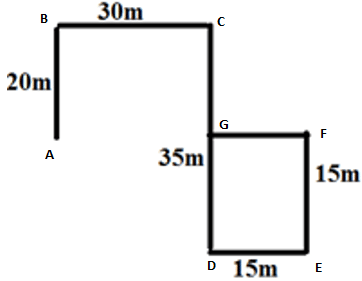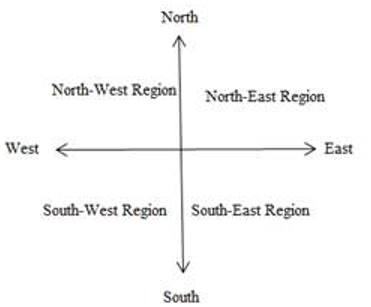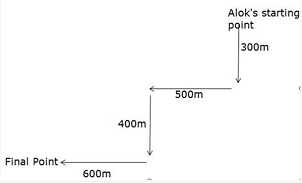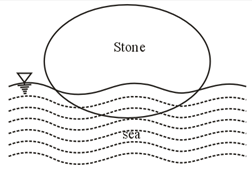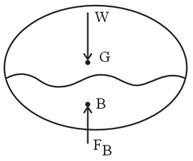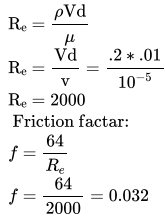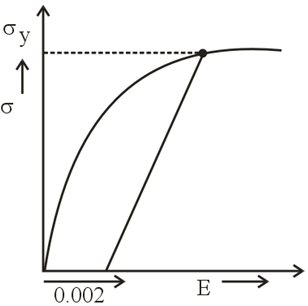Practice Test: Mechanical Engineering (ME)- 14 - Mechanical Engineering MCQ
30 Questions MCQ Test - Practice Test: Mechanical Engineering (ME)- 14
A person invests Rs. 1000 at 10% annual compound interest for 2 years. At the end of two years the whole amount is invested at an annual simple interest of 12% for 5 years. The total value of the investment finally is;
Direction: Study the information given below and answer the questions based on it.
Kiran walks 20m north, she turns right and walks 30m, then she turns right and walks 35m, then she turns left and walks 15m, then she turns left and walks 15m. She again turns left and walks 15m.
How far Kiran is from her starting point?
| 1 Crore+ students have signed up on EduRev. Have you? Download the App |
Direction: Study the bar graph carefully and answer the given questions.
The bar graph shows the total number of adult male and the average number of adult female and children together in different villages from A to F in 2017.
The total number of people in a village= Total number of adult male+ Total number of adult female + Total number of children

If in village A, the ratio of the total number of the adult male to the total number of children is 5:3 and the total number of an adult female in village D is 60 more than that of the total number of an adult female in village A then find the total number of an adult female in village D?

Direction: In the following question, some part of the sentence may have errors. Find out which part of the sentence has an error and select the appropriate option. If a sentence is free from error, select ‘No Error’.
If this be overlooked, a wrong (1)/ impression may be derived as (2)/ to the most absolute amplitudes of the changes. (3)/ No error (4)
Which of the following is the meaning of 'Ginger up'?
Alok drove his car 300m south and took right turn and moved 500m and took left turn and moved 400m and finally, he turned right and drove 600m. Now Alok’s starting point is in which direction of his final point?
Direction: In the following question, a set of labelled sentences is given. Out of the four alternatives, select the most logical order of the sentences to form a coherent paragraph.
P) Nor do they stomp around in desperate, frenzied rage.
Q) Naturally, a chance glance at 19-year-old Trishna would in no way divulge the trauma she has experienced.
R) Appearances are deceptive for, not all victims of drug abuse look the part they rarely don the dazed, lost countenance of one in the vice-like grip of drugs.
S) Even if temporarily denied their dose of ecstasy.
A bag contains 14 red and 6 white balls. Two balls are drawn at random. What is the probability that they are of the same color?
Direction: A sentence with two blanks is given, each blank indicating that something has been omitted. Choose the words that best fit the meaning of the sentence as a whole.
The dispute, according to observers, _________ the overall difference in opinion between developed and developing countries on whether _______ alone should be a part of the NDCs or whether adaptation and the means of implementation should also be included.
Direction: A statement with one blank is given below. Choose the set of words from the given options which can be used to fill the given blank.
The actor has seven characters ______________, and all of them are completely diverse from one another.
i. over his belt
ii. over the belt
iii. under his belt
A big stone has 60% of its volume projecting above the surface of the sea. The sea water density is 1025 kg/m3. The density of stone is
A frictionless fluid of density ρ flow through the circular pipe as shown in the figure. The force (in N) exerted on segment A – B of the pipes.

Far a fully developed flow of water in a pipe having diameter 10cm, with velocity 0.2m/s and kinematic viscosity 10−5m2/s. the value of darcy friction factor.
Sand acquires a predetermined shape under pressure and retains the same when pressure is removed. This is due to the property of sand known as:
The modulus of elasticity of Aluminum is 69 GPa, if material is loaded with tensile stress, find the Yield Stress.
For the given figure, calculate the bending moment (in kN-m) at 4m from the right end.

Following is the incomplete final table of simplex procedure:

From this one can conclude that the
Which among the following rotary compressor has high compression ratios as compared to reciprocating compressors?
Find the volume percentage of H2O when Methane is burned in an 50% oxygen rich atmosphere with respect to stoichiometric requirement.
Which assumptions are incorrect in column theory?
In an axial flow compressor, when the degree of reaction is 50%, it implies that
A 9m thick steel bar is to be horizontally cast with two correctly top riser of adequate feeding capacity. Assuming end effect without chill what should be the theoretical length to the bar
A sine bar has a length of 200mm. Each roller has a radius of 15mm. During taper angle measurement, the height from the surface plate to the stacked slip gauges is 150mm. The taper angle in degree is_________.
Maximum number of phase possible in a binary phase diagram is?
A pressure-crank angle diagram for the SI engine is shown, which is showing different stages of combustion.

The stage BC is
For a crank and slotted lever mechanism the length of the slotted bar is 750 mm and the length of the fixed link is 250 mm while the radius of the crank is 100mm. The quick return ratio of the mechanism is 2.5 and there is no slip of the ram while it is following translation. Find the stroke length in mm?
A 30 mm diameter shaft is driven at 12 Hz by a motor delivering 25 kW of power. The maximum shear stress in the shaft is?
If A = ![]() then the sum of eigen values of A3 is__________.
then the sum of eigen values of A3 is__________.
A rigid link PQ is 2m long and oriented at 200 to the horizontal as shown in the figure. The magnitude and direction of velocity VQ, and the direction of velocity VP are given. The magnitude of VP in (m/s) at this instant is.

A pulley of radius 500 mm is keyed to 25 mm radius of shaft by a 14 mm square key of length 150 mm. The tension in the tight side of the belt is 5000 N and tension ratio is 2 : 1. If ultimate shear strength is 250 MPa, then what will be the factor of safety in shear for key?


